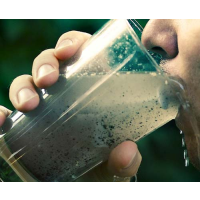Many Californians Rely on Contaminated Groundwater Sources for Drinking

A lot of California groundwater is contaminated. Naturally occurring arsenic is the main culprit, followed by not-so-naturally-occurring nitrate, perchlorate, tetrachloroethylene and trichloroethylene.
Around 30% of water deliveries in the state come from the ground—more during droughts—and more than one in five of these 3,037 community water systems that serve 21 million people are providing water that was contaminated before treatment, according to a new report from the State Water Resources Control Board. The state has 10 times as much groundwater storage capacity as all of its surface reservoirs.
Most of the communities spend a significant amount of money to either treat or blend their water to meet health standards, but not all. Around 2 million people rely on groundwater from either a private domestic well or a smaller groundwater-reliant system that isn’t regulated by the state. Many of these well owners don’t know the quality of their well water, because they aren’t required to test it.
Seventy-five percent (507) of the 680 community water systems count on groundwater for all their drinking supply. Some of them are poor, small water systems that cannot afford water treatment, the report said. Kern, Tulare and Madera counties have the most community water systems with contaminated sources.
The California Department of Public Health, which regulates community water systems, found during its most recent survey that 265 of the 680 systems in question used a groundwater source that exceeded a public drinking water standard.
Although 31 different contaminants were identified in the water board’s report, arsenic was by far the most prevalent. The naturally occurring chemical was found in 287 of the water systems. Nitrate contamination was found in 205 systems. It leaches into the ground primarily from agricultural fertilizers, although other sources, notably septic tanks and dairies, can be a factor.
The U.S. Environmental Protection Agency (EPA) has estimated that the state will need to spend $40 billion over the next 20 years to ensure the delivery of safe drinking water.
–Ken Broder
To Learn More:
Many in Calif. Rely on Contaminated Water Sources (Associated Press)
Communities that Rely on a Contaminated Groundwater Source for Drinking Water (State Water Resources Control Board) (pdf)
State Study Finds Numerous Communities Rely on Contaminated Groundwater Sources for their Drinking Water Supply (State Water Resources Control Board) (pdf)
California’s Groundwater Problems and Prospects (by Jay R. Lund and Thomas Harter, UC Davis Center for Watershed Sciences)
- Top Stories
- Controversies
- Where is the Money Going?
- California and the Nation
- Appointments and Resignations
- Unusual News
- Latest News
- California Forbids U.S. Immigration Agents from Pretending to be Police
- California Lawmakers Urged to Strip “Self-Dealing” Tax Board of Its Duties
- Big Oil’s Grip on California
- Santa Cruz Police See Homeland Security Betrayal in Use of Gang Roundup as Cover for Immigration Raid
- Oil Companies Face Deadline to Stop Polluting California Groundwater





